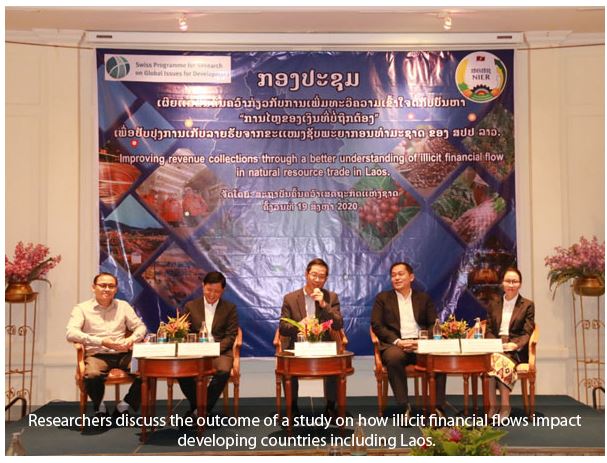Laos at potential risk of illicit financial flows: study
Laos is potentially at risk of illicit financial flows (IFF) but there is no clear evidence to investigate the problem and its possible magnitude, according to researchers.
The National Institute for Economic Research unveiled the outcome of a study in Vientiane yesterday, to clarify understanding of illicit financial flows in the natural resource trade in Laos.
The study results were released after many resource-rich developing countries have lost huge amounts of revenue due to illicit financial flows, affecting economic growth and efforts to implement sustainable development goals.
According to a World Bank report, money illegally earned, transferred, or used that crosses borders is the most common definition of illicit financial flows.
The institute’s Acting President, Dr Sthabandith Insisiengmay, highlighted the problem of IFF in developing countries, suggesting that revenue collection from the natural resource sector was well below its potential.
Developing countries lose US$160 billion a year from transfer mispricing and false invoicing while illicit financial flows from Africa between 1980 and 2018 were estimated to total about US$1.3 trillion.
According to a report from the United Nations Office on Drugs and Crime, corruption and illicit financial flows are still major impediments to development in Laos.
The UNODC also stated that the landlocked country is among the top 20 Least Developed Countries with the highest level of illicit outflows at 14.42 percent of Gross Domestic Product (GDP).
It’s critical to note that the country’s total domestic revenue accounted for 14.3 percent of GDP in 2018, compared to 19.9 percent in Cambodia and 19.5 percent in Thailand.
Laos relies heavily on the natural resource sector as an essential source of growth, exports, FDI, and government revenue.
Despite the government’s efforts to expand the tax base as a priority for revenue improvement, empirical evidence suggests there are risks of tax base erosion due to IFF. Therefore, the study on the existence, magnitude and channels of IFF could motivate a well-targeted regulatory response in Laos.
A study of the coffee and copper trade to examine IFF as a result of trade mispricing practices contributes to new understanding of this issue. However, further study is needed to clarify the mechanisms involved.
Three export products were examined in the case study, namely copper cathodes, copper concentrate or ores, and coffee beans, with the study focusing on trade between 2012 and 2017.
The study found that Laos lost about US$3.1 million from the mispricing of coffee exports, which is supposed to yield profit tax.
The invoice prices of coffee bean exports were found to be below the arm’s length price during the study period. If the value of coffee sales were valued at the market level, the government could collect more revenue from coffee exports. But companies reported less income than they actually earned from exports as a way to evade tax payment.
Illicit financial flows reduce domestic resources and tax revenue needed to fund poverty-reducing programmes and infrastructure in developing countries; accordingly, they are receiving growing attention as a key development challenge.
Source: http://www.vientianetimes.org.la/freeContent/FreeConten_Laos161.php


 Thailand
Thailand




